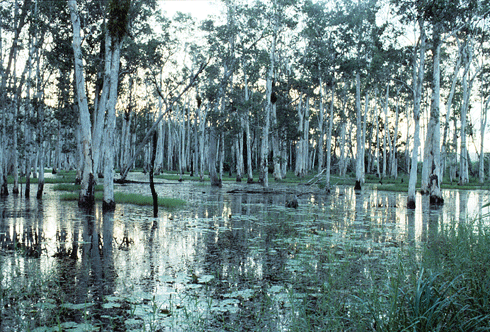
|
Published: 5 December 2011
Race on to counter rust’s threat to the bush and industry
Myrtle rust fungus, thought to be from South America, appeared in New South Wales last year and is spreading rapidly, infecting Australia’s dominant myrtaceous plants and posing a significant threat to ecology and the economy.
Leading a widening research effort, scientists in the Cooperative Research Centre for National Plant Biosecurity (CRCNPB) are racing to understand the disease, its spread, and which species are at risk in order to develop a national management strategy.
The yellow powdery rust withers the new growth of plants in the myrtaceae family1 which includes the familiar eucalyptus and melaleucas. The infection zone now extends up through Queensland in a 2000 km corridor along the east coast of Australia. Myrtle rust spreads through microscopic airborne spores, and via animal and human interaction.
Biosecurity experts believe the fungus can no longer be contained, and its impacts are likely to extend to those animals that rely on myrtaceae, and to the many industries that utilise myrtaceous products. Not all the Australian myrtaceae tested so far appear vulnerable, but most are, and all states may be affected.
Mike Ashton, Director of Biosecurity Queensland’s Myrtle Rust Program, which is leading the CRCNPB’s myrtle rust project, reported that the disease has shown up in several national parks and World Heritage Areas, and that, so far, more than 100 species in the myrtaceae family have been found to be susceptible to the rust.
He says that beyond possible tourism effects, there could be a social impact as the disease spreads further in public parks and people’s backyard gardens.
CRCNPB CEO, Dr Simon McKirdy, says the Centre is prioritising research into Myrtle rust fungus to determine its potential host and geographic range, study its epidemiology and to try to forecast impacts in the Australian environment.
‘Australia now experiences, on average, around 30 new invasions by species damaging plants and crops every year. Eucalyptus or myrtle rust is one of the worst we have ever seen, because of the wide range of native species it can attack. This is as close to a national plant health emergency as it gets,’ he says.
Speaking to Ecos, Mr Ashton said that, short term, research was focusing on monitoring and estimating the rust’s spread and impact on ecology for immediate management planning, but that a longer-term view was being taken to limit its effects, including finding and breeding resistant myrtaceae species and testing fungacides. CSIRO is one organisation involved with the broader research efforts, including looking into breeding resistance.
Mr Ashton said the CRCNPB was leading with research and development efforts helped by funding of about $1.5 million from the federal government, while the Queensland government had also committed $800 000 this year to combat rust.
‘Given the potential for the damage rust may cause, there is a broadening research scope, and we need all the support we can get.’
Mr Ashton said the community was being encouraged to assist by reporting the spread of Myrtle rust through the Biosecurity Queensland and CRCNPB websites.
Source: CRCNPB release
1 See http://en.wikipedia.org/wiki/Myrtaceae




